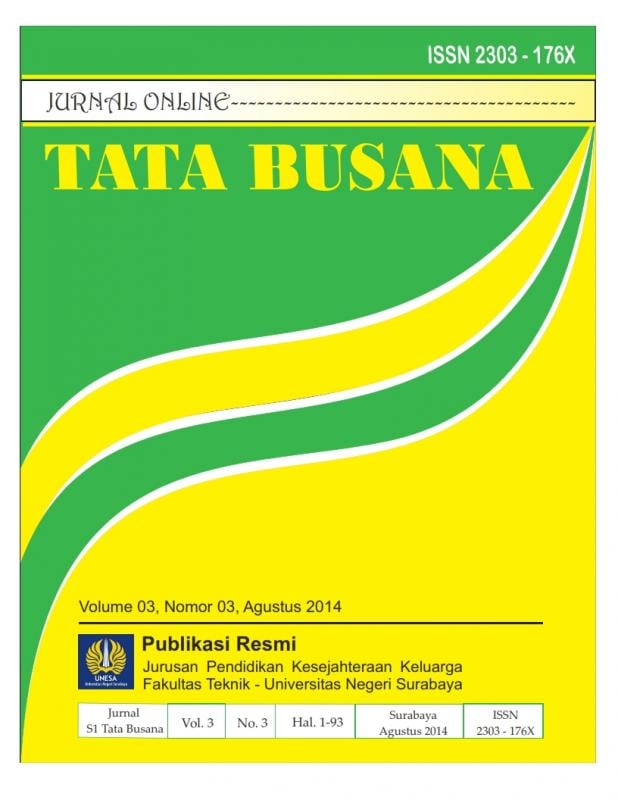Perbedaan Ukuran Pola Smock Terhadap Hasil Jadi Variasi Flower Smocking Pada Busana Pesta Anak
DOI:
https://doi.org/10.26740/jurnal-online-tata-busana.v3i3.8588Abstract
Abstrak
Variasi flower smocking merupakan salah satu dari bentuk Nort American smocking yang divariasi. Variasi flower smocking ini diterapkan pada busana pesta anak dengan membedakan ukuran pola ½ cm, 1 cm, dan 1 ½ cm. Tujuan dalam penelitian ini yaitu untuk mengetahui hasil jadi variasi flower smocking dengan ukuran pola smock ½ cm, 1 cm, dan 1 ½ cm yang diterapkan pada busana pesta anak, untuk mengetahui ada tidaknya perbedaan hasil jadi antara smock yang menggunakan ukuran pola ½ cm, 1 cm, 1 ½ cm pada busana pesta anak, untuk mengetahui hasil jadi yang terbaik antara variasi flower smocking dengan ukuran pola smock ½ cm, 1 cm, 1 ½ cm yang diterapkan pada busana pesta anak. Jenis penelitian ini adalah eksperimen yang memiliki variabel bebas yaitu penambahan ukuran pola smock yaitu ukuran smock ½ cm. 1 cm, dan 1 ½ cm. Variabel terikat yaitu hasil jadi variasi flower smocking pada busana pesta anak. Variabel kontrol yaitu desain busana pesta anak, smock yang dibuat adalah variasi flower smocking, kain yang digunakan adalah kain satin polyester, teknik menjahit, orang yang mengerjakan variasi flower smocking dan busana pesta anak, alat yang digunakan. Metode pengumpulan data adalah observasi dengan observer 30 orang. Untuk analisis data menggunakan anava tunggal. Hasil penelitian ini menunjukkan hasil jadi variasi flower pattern pada busana pesta anak ditinjau dari aspek kerapian, aspek bentuk, aspek jatuhnya smock. Untuk ukuran smock ½ cm kurang baik, pada ukuran smock 1 cm hasilnya baik, dan pada ukuran smock 1 ½ cm hasilnya baik. Jadi ada pengaruh yang signifikan pada semua aspek, yaitu kerapian, bentuk, dan jatuhnya smock. Hasil jadi smock yang terbaik adalah ukuran pola 1 cm karena proporsi pada busana pesta anak.
Kata Kunci: Variasi flower smocking, Busana Pesta Anak
Abstract
Variation flower was smocking is one of the form of north west frontier american smocking that divariasi. Variation flower was smocking is applied to fashion a party child with distinguish the size of the pattern 0,5 cm, 1 cm, and 1,5 cm. Purpose in this research is to find out the results of so variation flower was smocking with the size of the pattern smock 0,5 cm, 1 cm, and 1,5 cm applied to fashion a party children, to know the whereabouts differences between smock the result so that uses the size of the pattern 0,5 cm, 1 cm, 1,5 cm in fashion party children, to know the result so the best between variation flower was smocking with the size of the pattern smock 0,5 cm, 1 cm, 1,5 cm applied to fashion a party child. A kind of this research is an experimenter whose having variable free that is, an increase in the size of the pattern smock which is a measure smock 0,5 cm.1 cm, and 1,5 cm. Variable bound namely the result so variation flower was smocking on fashion party child. Variable control namely. party children, fashion designs smock made is a variant flower was smocking, cloth used is cloth of satin polyester, the technique of needlework, a person who tills variation flower was smocking party children, and fashion a tool used. A method of collecting data is observation with an observer 30 people. To analysis of data using anava single. This research result indicates the result so variation flower was pattern on fashion party child review of the aspect of neatness, aspect of the form of the size, aspect of the fall of smock. To the size of a smock 0,5 cm less properly, on the size smock 1 cm the result is good and on the size smock 1,5 cm the result is good.So there are significant influence on all aspects, neatness, namely form, and the collapse of a smock.The result so smock the best is size of the pattern of 1 cm due proportion in fashion party child.
Keywords: variation of flower smocking Dress, childrens party.
Downloads
Downloads
Published
How to Cite
Issue
Section
 Abstract views: 152
,
Abstract views: 152
, PDF Downloads: 264
PDF Downloads: 264


